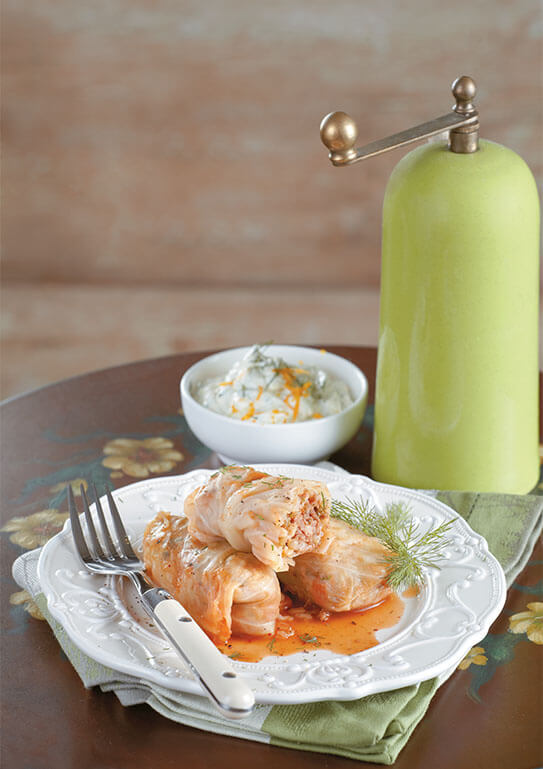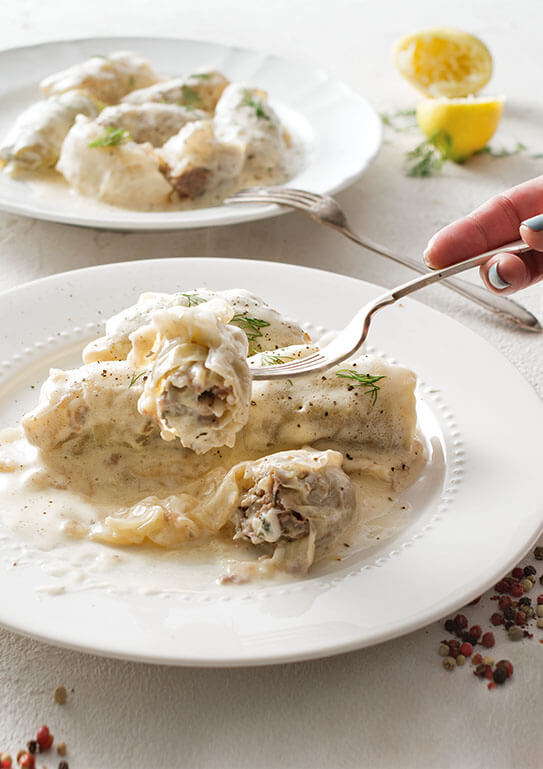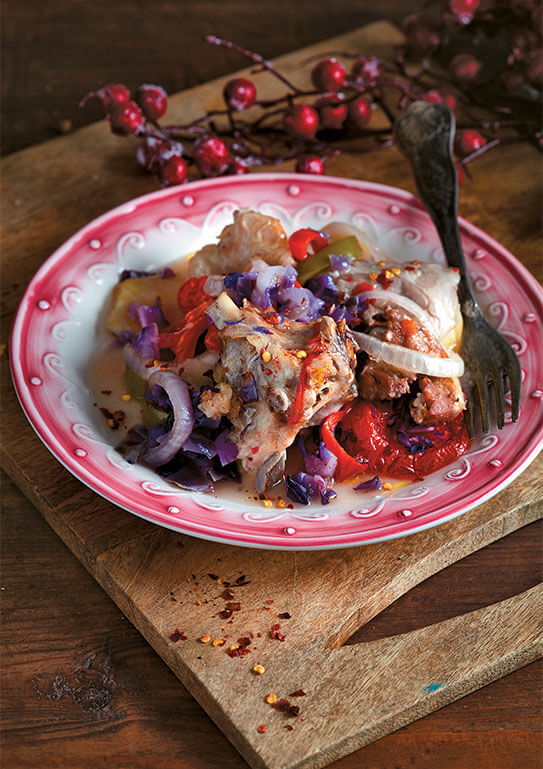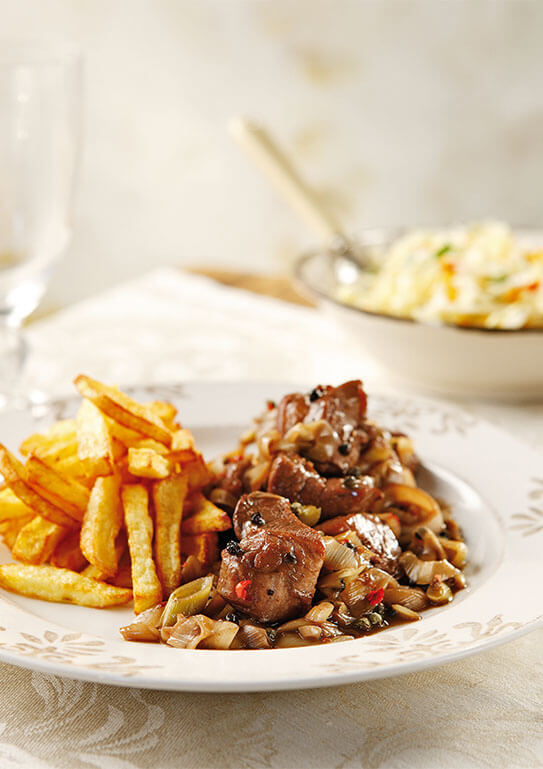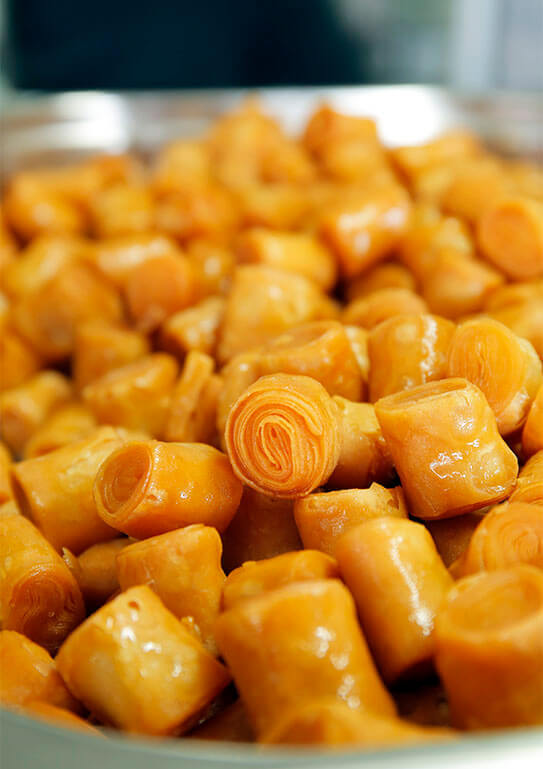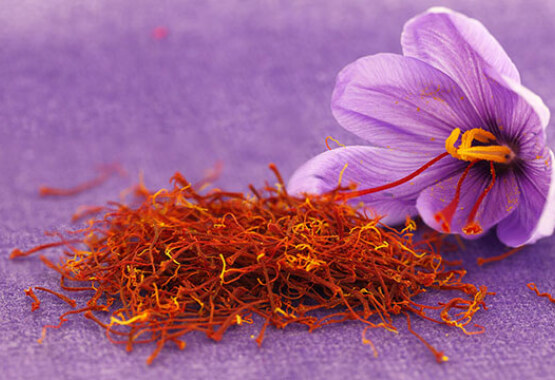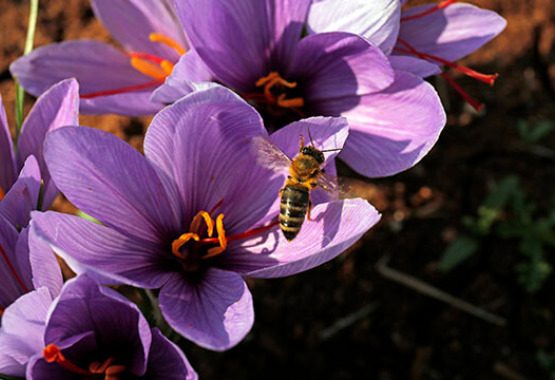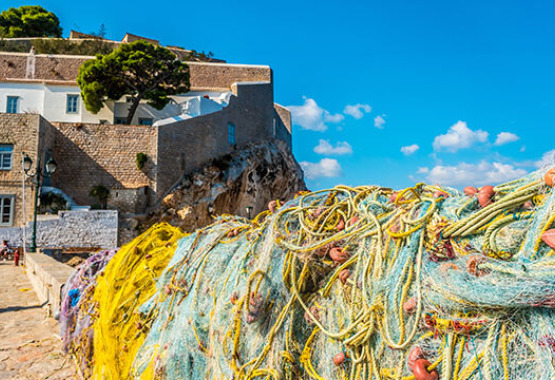
KOZANI
Giaprakia, the most popular local dish, which used to be enjoyed on the Christmas table only, is now served in several restaurants especially during the winter months. It is made with leaves of pickled white cabbage (locally known as lachanarmia) stuffed with rice, minced meat, usually half pork & half beef, and plenty of allspice berries, which the locals call moschopipero. The more adventurous diners add pork lard or pancetta and of course lots of paprika. Meatballs in juice are also popular. The juice - or zmi in the local dialect - is a sauce prepared with water, flour, garlic, oil and red pepper.
Pan-fried pork with leeks, popular throughout Western Macedonia, is a regular dish on the local table, while gizlemopita, a pie with minced meat, leeks and noodles, is a regional speciality. Boubaria, which goes by various names in many parts of Greece, consists, in its Kozani version, of a large intestine or tripe, stuffed with minced pork, liver, rice, onions and many herbs, spearmint in particular. The spiral-shaped Kichi pies stuffed with feta cheese are also renowned.
THe Kozani cuisine includes all kinds of pies stuffed with aubergine, cheese, meat, spinach, trachanas (a type of frumenty), leek, onion, nettle and more. Pickles are also common, as in the past this was the only way to preserve vegetables.
There are also hot and cold soups, such as the refreshing tiratori (in other parts of Macedonia it is known as taratori). It is made with crushed garlic, cucumber, salt, vinegar, oil, water and often bread or nuts, and in older times it was consumed in the summer by field workers during their work-break. Meats are grilled or cooked, with skewered kontosouvli (aka souglitses) and soutzoukakia ranking high in the list of dishes served in village tavernas.
Other dishes that are prepared, albeit not that often anymore, include kapama, a braised tomato meat stew with plums or quinces; lamb with parsley, and katafiotiko (lamb cooked with vegetables) in the summer; chicken with chestnuts, or rooster with noodles on formal occasions; large white onions or quince stuffed with minced meat; tsitsilato, lamb soup cooked with plenty of herbs and spinach which is served at Easter; hare stew, and other game.
Local sweets include saliaria (pastry filled with walnuts), moustopita (with grape molasses and corn flour), sitzoukia (with grape molasses and walnuts), tziam pliaf (made with rice, sugar, vermicelli and cinnamon), scalded kourabiedes (with syrup instead of caster sugar), a wintertime dish called ksiafi (compote with dried fruits), haslamas (which looks like the syrupy samali dessert, but more fluffy), a wide variety of spoon sweets, pastes, including that of quince, and syrupy sweets like kourkoubinia (bites made of rolled phyllo pastry), touloumpakia (deep-fried dough bites) and loukoumades (bite-sized fluffy honeyed balls), prepared in Velventos.
The Cuisine of Kozani
Time-honoured recipes & delicious flavours
The culinary tradition of Kozani is a blend of influences from the different populations that settled in the area or passed through. This tradition was moulded by the availability of produce, as determined by the soil and the climate. The influences of the Vlachs and the Greek refugees that arrived from Anatolia after 1922, especially the Pontians, are obvious, as are those from the surrounding Balkan countries. In the past, there was a pronounced difference in eating habits between the rural or livestock breeding communities and the urban centres, with the former consuming mainly legumes and any vegetables that grew in the area. Meat was almost exclusively reserved for festive occasions and official events. In contrast, the cuisine of urban areas relied on a wider variety of ingredients and more sophisticated techniques. Obviously, as modernization and economic growth prevailed, and, primarily, because travelling became easier, many of the traditional recipes, especially those which were - so far by necessity - based on a few standard ingredients, have disappeared from the daily menus and are nothing more than a memory.Giaprakia, the most popular local dish, which used to be enjoyed on the Christmas table only, is now served in several restaurants especially during the winter months. It is made with leaves of pickled white cabbage (locally known as lachanarmia) stuffed with rice, minced meat, usually half pork & half beef, and plenty of allspice berries, which the locals call moschopipero. The more adventurous diners add pork lard or pancetta and of course lots of paprika. Meatballs in juice are also popular. The juice - or zmi in the local dialect - is a sauce prepared with water, flour, garlic, oil and red pepper.
Pan-fried pork with leeks, popular throughout Western Macedonia, is a regular dish on the local table, while gizlemopita, a pie with minced meat, leeks and noodles, is a regional speciality. Boubaria, which goes by various names in many parts of Greece, consists, in its Kozani version, of a large intestine or tripe, stuffed with minced pork, liver, rice, onions and many herbs, spearmint in particular. The spiral-shaped Kichi pies stuffed with feta cheese are also renowned.
THe Kozani cuisine includes all kinds of pies stuffed with aubergine, cheese, meat, spinach, trachanas (a type of frumenty), leek, onion, nettle and more. Pickles are also common, as in the past this was the only way to preserve vegetables.
There are also hot and cold soups, such as the refreshing tiratori (in other parts of Macedonia it is known as taratori). It is made with crushed garlic, cucumber, salt, vinegar, oil, water and often bread or nuts, and in older times it was consumed in the summer by field workers during their work-break. Meats are grilled or cooked, with skewered kontosouvli (aka souglitses) and soutzoukakia ranking high in the list of dishes served in village tavernas.
Other dishes that are prepared, albeit not that often anymore, include kapama, a braised tomato meat stew with plums or quinces; lamb with parsley, and katafiotiko (lamb cooked with vegetables) in the summer; chicken with chestnuts, or rooster with noodles on formal occasions; large white onions or quince stuffed with minced meat; tsitsilato, lamb soup cooked with plenty of herbs and spinach which is served at Easter; hare stew, and other game.
Local sweets include saliaria (pastry filled with walnuts), moustopita (with grape molasses and corn flour), sitzoukia (with grape molasses and walnuts), tziam pliaf (made with rice, sugar, vermicelli and cinnamon), scalded kourabiedes (with syrup instead of caster sugar), a wintertime dish called ksiafi (compote with dried fruits), haslamas (which looks like the syrupy samali dessert, but more fluffy), a wide variety of spoon sweets, pastes, including that of quince, and syrupy sweets like kourkoubinia (bites made of rolled phyllo pastry), touloumpakia (deep-fried dough bites) and loukoumades (bite-sized fluffy honeyed balls), prepared in Velventos.





